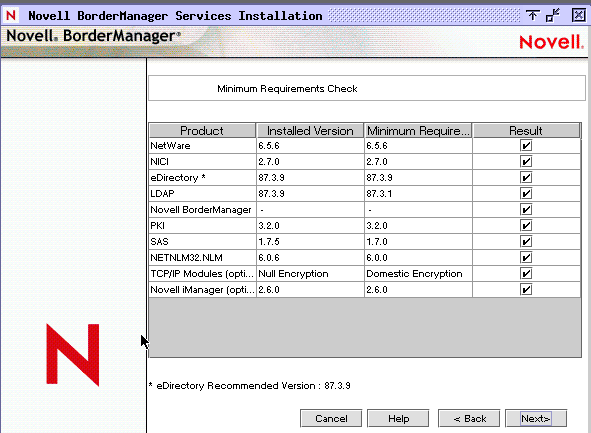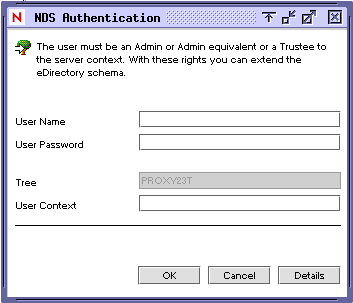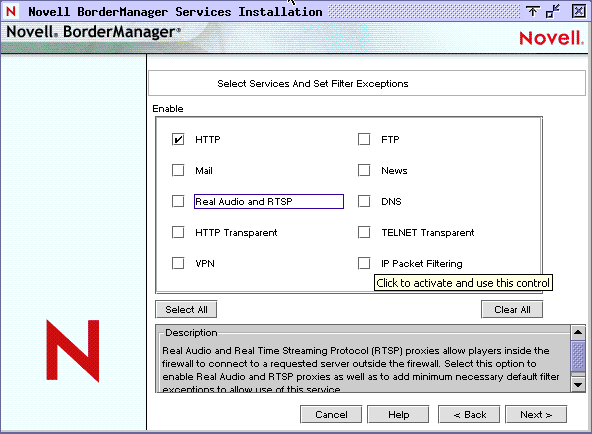2.2 Installation Procedure
To install Novell BorderManager 3.9 on the server:
-
Do one of the following:
-
If you are downloading the product from the Web, unzip Novell BorderManager 3.9 on a drive that is accessible from your server.
-
If you are using a product CD, mount the Novell BorderManager 3.9 CD on the server by entering CDROM at the server console.
-
-
On the server side, go to the X-Server Graphical Console. If the X-Server Graphical Console is not loaded, enter STARTX at the server console.
If STARTX is already loaded, press Ctrl+Esc and select the option for X-Server Graphical Console.
-
Click , then select to display the list of currently installed products.
-
Click , then browse to the root of the Novell BorderManager 3.9 directory and select product.ni, which is displayed in the right frame. Click .
-
Click . The Welcome page is displayed.
-
Click . The License agreement page is displayed.
-
Read the license agreement. If you accept the terms of the agreement, click . The Novell Border Manager Services installation page is displayed.
-
Select the check boxes next to the services you want to install them.
-
Select or shipping license from the drop-down list. Trial Licenses are selected by default. Trial and Shipping licenses are located in the directory at the root of the CD.
-
Click . The Minimum Requirements page is displayed.

The Minimum Requirements page displays the installed version as well as the minimum requirement version of the software.
If any of the minimum requirements except TCP/IP modules or iManager 2.6 is not met, the installation stops. Meet the requirements according to the displayed table in the minimum requirements page and restart the installation.
If the base requirements for the TCP/IP modules are not met, a warning is displayed. You can ignore the warning and install, but you need to copy the right TCP/IP modules later if you want to use VPN services.
If iManager 2.6 is not installed, the plug-ins for Novell BorderManager Firewall Configuration, Novell BorderManager Proxy configuration, and Novell BorderManager VPN Configuration are not installed. If that is the case, install iManager 2.6 after Novell BorderManager installation to automatically install the Novell BorderManager Firewall Configuration and Novell BorderManager VPN Configuration plug-ins.
If the minimum system requirements are met, click to proceed.
-
On the NDS Authentication page, specify your credentials to log in.

User Name: Specify either your fully distinguished name (FDN) or provide only the name. You must have administrative rights to the root of the eDirectory tree. This requirement applies to any user who is a trustee with Supervisor rights at a container at the same level as the server. Administrative rights are required to extend the eDirectory schema, install product licenses, and configure Novell BorderManager 3.9 for the first time.
User Password: Specify your password.
Tree: Specify the name of the tree.
User Context: Specify the user context in the tree. You must specify this information if you have not entered your FDN in the field.
-
Click .
-
If you are installing Novell BorderManager firewall/caching services or Novell BorderManager VPN services, review the list of network interfaces and their IP bindings.
For firewall and caching services, you must specify a public IP address to secure the network border. Public IP addresses specify server interfaces to a public network, typically the Internet. Private IP addresses specify server interfaces to a private network or intranet.
-
Select the or check box to specify a network interface as public, private, or both for proxy and firewall services.
-
Specify the default gateway in the .
-
By default, the check box is selected. Deselect the check box if you do not want to install the iManager plug-ins.
-
-
Click . The Novell BorderManager Services Installation page is displayed.
-
Select the check boxes for the services that you want to enable. Filter exceptions for these services are created on the public interface.

On a single interface machine, filter exceptions are created but the filters are not enabled. Filter exceptions corresponding to the selected services are created on the public interface. Filter exceptions are activated along with the filters if is selected. IP packet filtering is not enabled if only one interface is available. If this is an upgrade, existing filters are preserved. is not set on public interfaces.
-
Click .
-
(Optional) If you selected , select either or both of the External/Internal check boxes in order to set appropriate filter exceptions, depending on whether you want to proxy internal mail servers, external mail servers, or both. Specify the name of one domain for the mail proxy.
-
(Optional) NetWare provides the facility to create cache volumes automatically. If HTTP, FTP, HTTP Transparent is selected in the Select Services and Filter Exception page, click and provide the required details to create traditional volumes for caching. You can also use existing traditional volumes for caching.
NOTE:If you do not create a volume or select a traditional volume for caching, the sys:\etc\proxy\cache directory is used.
To create a new cache volume, see the Novell BorderManager 3.9 Troubleshooting Guide .
-
The check box is enabled by default. We recommend that you accept the default. Access control enforces additional security by denying all proxy services traffic.
Access control rules can be set using the iManager. Access rules are used to allow or deny access from any source or to any destination. This option comes up only if you selected on the previous page.
-
Click to continue.
-
Specify a unique DNS domain name for your network in the field, then click .
-
Click , then specify at least one or up to three DNS server IP addresses. By default, the existing DNS entry is used.
Use the and buttons to move the order of IP addresses, if you have added two or more IP addresses.
To delete a DNS server IP address, click .
-
Click to continue.
-
By default the check box is selected. Deselect the box if you do not want the plug-ins to be installed.
Click .
-
Click if you are done, or click to return to previous pages and modify your selections.
-
Do one of the following:
-
Click for Novell BorderManager 3.9 services to come up.
-
Click to complete the installation and return to the GUI screen.
-
Click to view the Readme.
The install summary is available in sys:\ni\data\nbm_instlog.csv. The Readme is available at the root of the CD under Documents/ReadMes/enu.
-